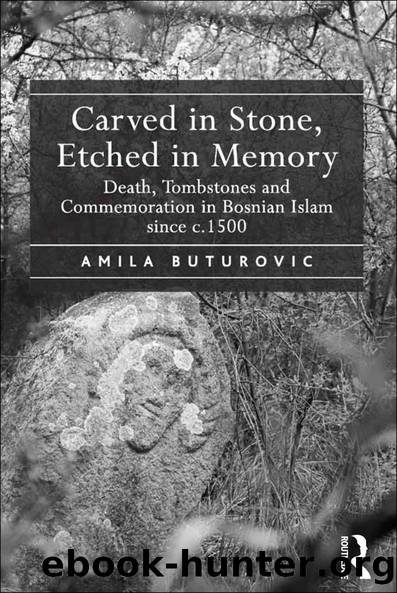Carved in Stone, Etched in Memory by Amila Buturovic

Author:Amila Buturovic [Buturovic, Amila]
Language: eng
Format: epub
Tags: History, Modern, 17th Century, Religion
ISBN: 9781317169567
Google: nWCrCwAAQBAJ
Publisher: Routledge
Published: 2016-03-03T01:26:44+00:00
Chapter 3
Converting the Stone: Text and Images in Early Ottoman Bosnia
The previous chapters situated various forms of Bosnian Muslimsâ commemoration of the dead â ritual, official and non-official, public and private â into the expansive field of memory studies and questions around spatial representation of death. Rather than existing as an abstract faculty, an object, or an esoteric mental reality to be summoned when needed, memory of the dead is recognised for its attachment to complex modes of signification associated with material and immaterial culture alike. Among different forms of memory, memory of the dead is particularly intricate because it is poised between the emotive expressions of bereavement, loss and remembrance and the ethical quandary regarding the transformation of the subject/person into the material object/remains with whom a personal and social relationship may continue. Furthermore, the dead who inhabit our space are assigned material and symbolic signification to help us reflect on continuity in the past, present and future. There is physical proximity between us and the dead, but also distance occasioned by new ontological configurations. Although the speaking, living subject is absent, materialised into remains and silenced by the burial act, s/he can be re-animated through cultural and political interactions. Private memories and public ritual acts, official and unofficial, play an important role in connecting visual markers of death and memory and activating the imaginative and narrative processes to make the relationship with the dead meaningful and unbroken in some situations, and dysfunctional and severed in others. Memorial markers can occasion contact, usher debates, generate conflict, lead to reinterpretation of history, and erase many dimensions of memory. In this sense, although memorial markers â gravesites, plaques, shrines, monuments â appear to be stable and impervious physical structures encouraging connection and remembrance, they also function as precarious and contentious arenas which are mapped symbolically as much as geographically. As such, they are important to examine in depth as primary cultural sources in which the dead come closest to self-identification and self-affirmation.
In light of these intersections between death and its material markings, this chapter will further explore the relationship between death and memory, focusing less on embodied ritual practice and more on the textual basis for the communication enshrined in the stone as image and word. The historical framework of this chapter is early Ottoman Bosnia, between the late fifteenth and late seventeenth centuries, during which the nascent Islamic community developed funerary literacy in reference to both local and imperial norms. The process of transition between the pre-Ottoman, dominantly Christian, cultural system into the Ottoman-Islamic one occasioned a confluence between different funerary styles, reflecting the broader issues of conversion and new eschatological sensibilities. How did early Muslims of Bosnia memorialise their ancestors, Christian and Muslim? What change in the commemorative culture did the conversion occasion? What do funerary data tell us in the absence of the speaking subjects?
In answering these questions, several observations are worthy of note: first, the physical geography of funerary texts is somewhat inconsistent. Some texts are chiselled
Download
This site does not store any files on its server. We only index and link to content provided by other sites. Please contact the content providers to delete copyright contents if any and email us, we'll remove relevant links or contents immediately.
| Africa | Americas |
| Arctic & Antarctica | Asia |
| Australia & Oceania | Europe |
| Middle East | Russia |
| United States | World |
| Ancient Civilizations | Military |
| Historical Study & Educational Resources |
Cecilia; Or, Memoirs of an Heiress — Volume 1 by Fanny Burney(32073)
Cecilia; Or, Memoirs of an Heiress — Volume 3 by Fanny Burney(31468)
Cecilia; Or, Memoirs of an Heiress — Volume 2 by Fanny Burney(31418)
The Secret History by Donna Tartt(18208)
Sapiens: A Brief History of Humankind by Yuval Noah Harari(13995)
Leonardo da Vinci by Walter Isaacson(12811)
The Radium Girls by Kate Moore(11633)
Sapiens by Yuval Noah Harari(5126)
How Democracies Die by Steven Levitsky & Daniel Ziblatt(4966)
The Wind in My Hair by Masih Alinejad(4850)
Homo Deus: A Brief History of Tomorrow by Yuval Noah Harari(4693)
Endurance: Shackleton's Incredible Voyage by Alfred Lansing(4513)
Man's Search for Meaning by Viktor Frankl(4297)
The Silk Roads by Peter Frankopan(4275)
Millionaire: The Philanderer, Gambler, and Duelist Who Invented Modern Finance by Janet Gleeson(4113)
The Rape of Nanking by Iris Chang(4024)
Hitler in Los Angeles by Steven J. Ross(3803)
Joan of Arc by Mary Gordon(3792)
The Motorcycle Diaries by Ernesto Che Guevara(3790)
